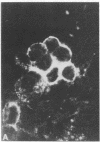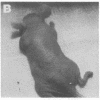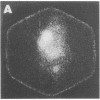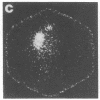Abstract
Several libraries of monoclonal antibodies have been produced by immunization of Balb/c mice with single cell suspensions of nontrypsin-treated human hepatocellular carcinoma cell (HCC) lines in order to study the antigenic properties of transformed hepatocytes. The antibodies were characterized with regards to specificity for hepatoma-associated antigens and their capability for use as reagents in radioimmunoassays (RIAs) and tumor localization in vivo. Three such antibodies namely, P215457, PM4E9917, P232524 of the IgG2a, IgG2a, and IgG1 isotypes, respectively, not only recognized separate and distinct antigenic determinants on four human hepatoma cell lines but also reacted with epitopes present on chemically induced rat hepatoma cell lines. In contrast, only 1 of 38 other human malignant and transformed cell lines demonstrated reactivity with the three antibodies; normal human tissues were also found to be unreactive. Monoclonal antibody P215457 densely stained the plasma membrane by indirect immunofluorescence, showed rapid binding activity to HCC cells in suspension, and precipitated a 50,000-mol wt cell surface protein; antibody PM4E9917 also stained the plasma membrane and precipitated a 65,000-mol wt protein, whereas P232534 recognized cytoplasmic antigenic determinants. With these antibodies "simultaneous sandwich" RIAs were established that detect soluble hepatoma-associated antigens in culture supernatants. Finally, the Fab fragment of P215457 was found to be useful in tumor localization in vivo. This antibody fragment when labeled with 131I was shown to localize by radionuclide-imaging studies in human hepatoma grown in nude mice. Thus, these investigations demonstrate that monoclonal antibodies may be produced against epitopes that reside almost exclusively on transformed hepatocytes and such antibodies may be successfully employed in the development of in vitro and in vivo immunoassays.
Full text
PDF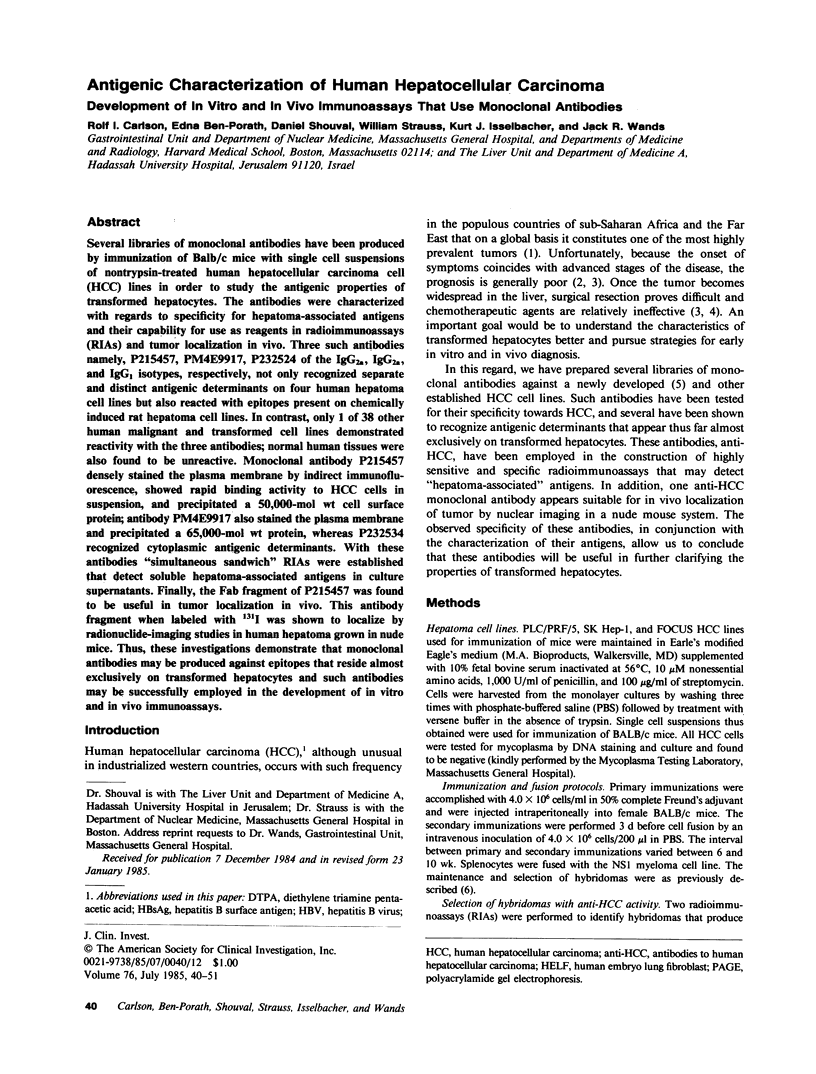
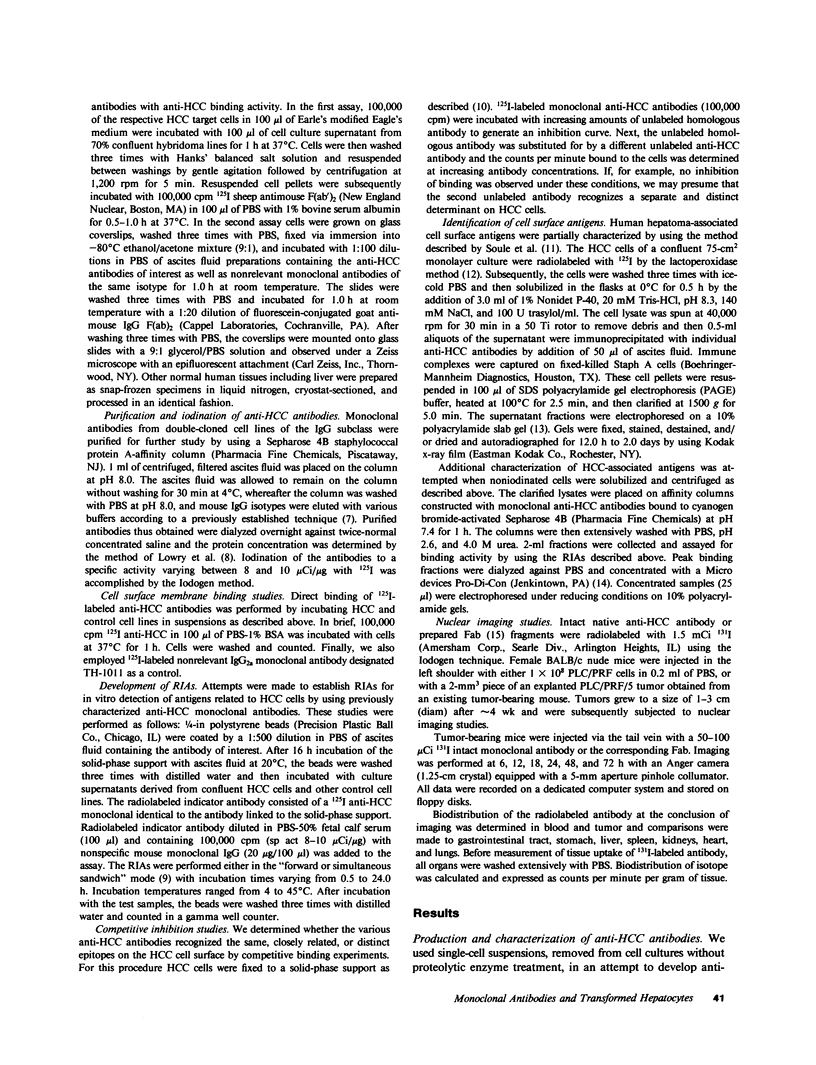
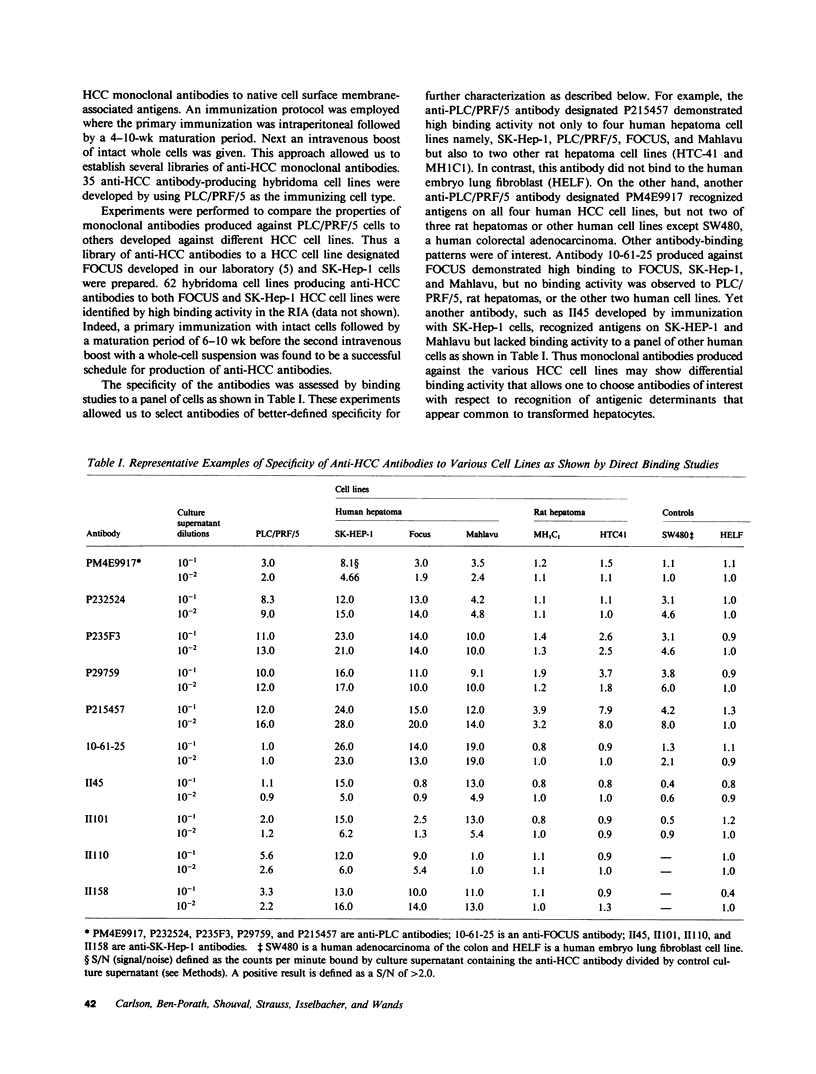
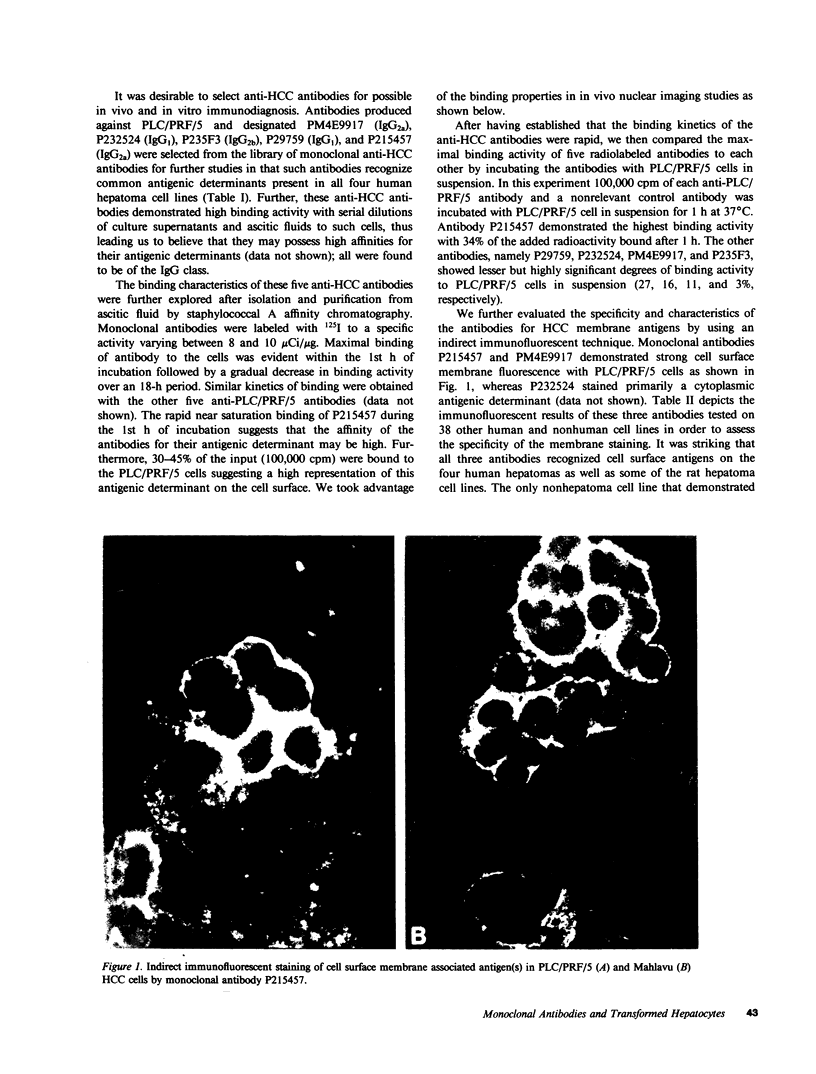
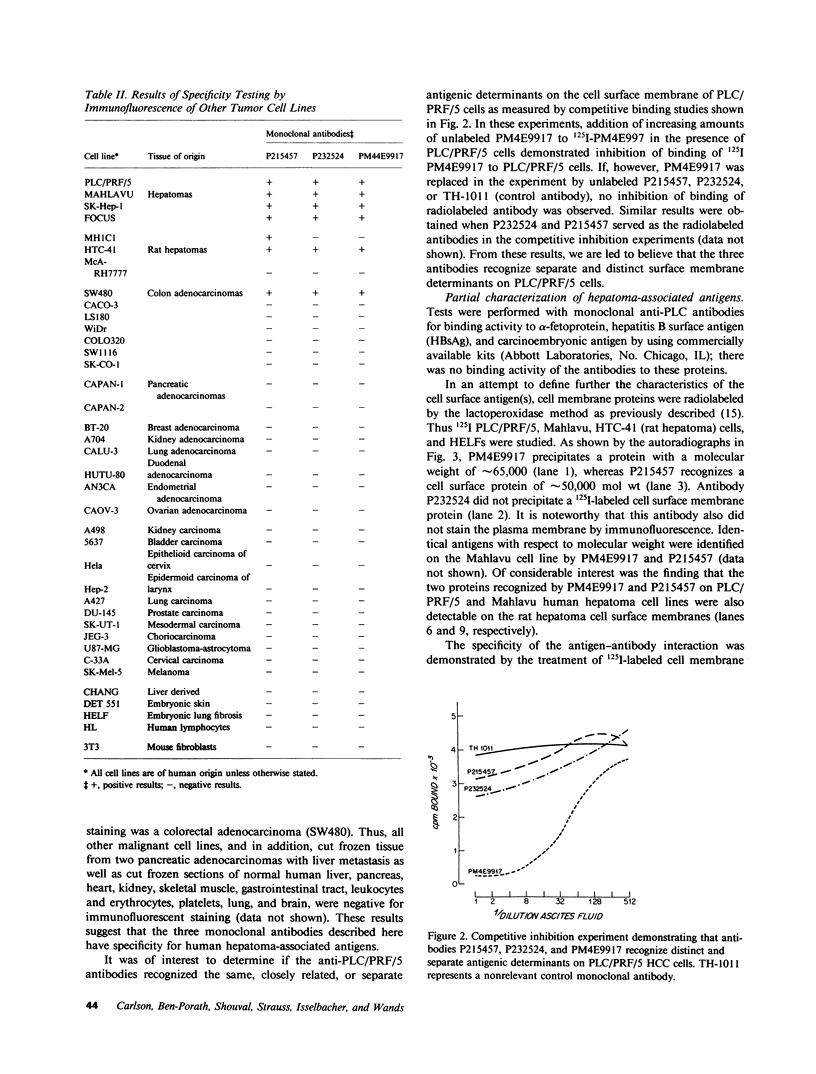
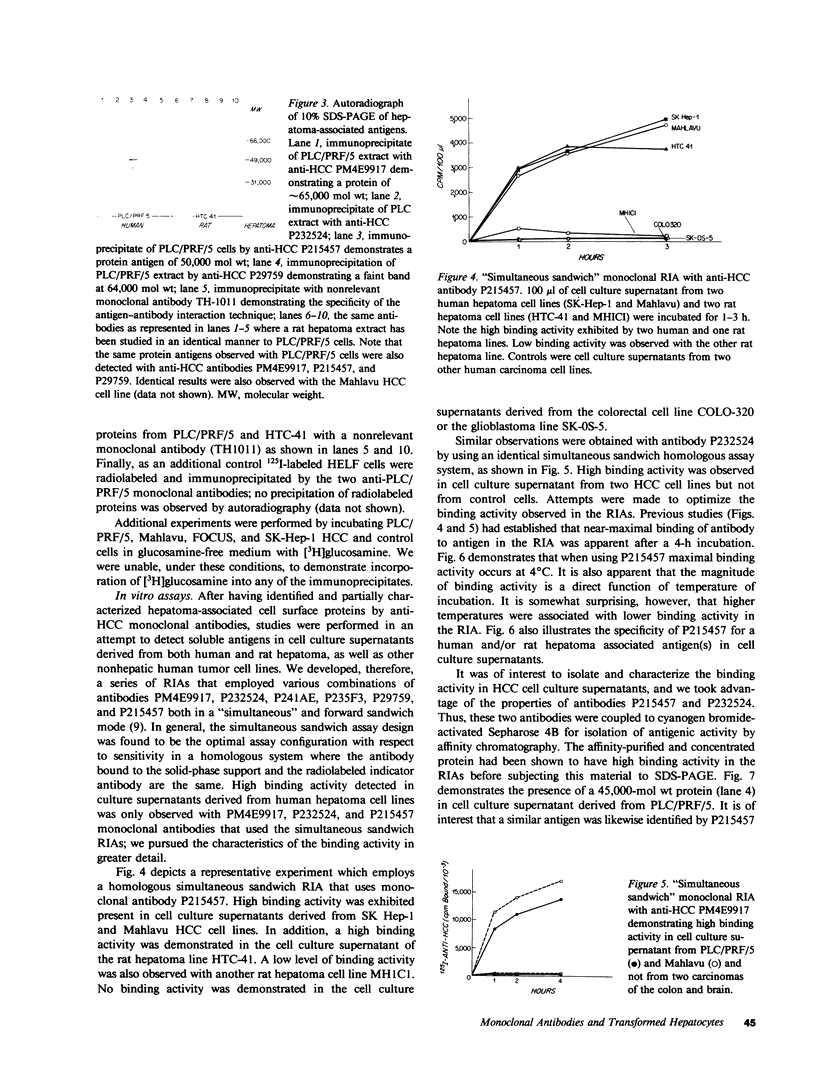
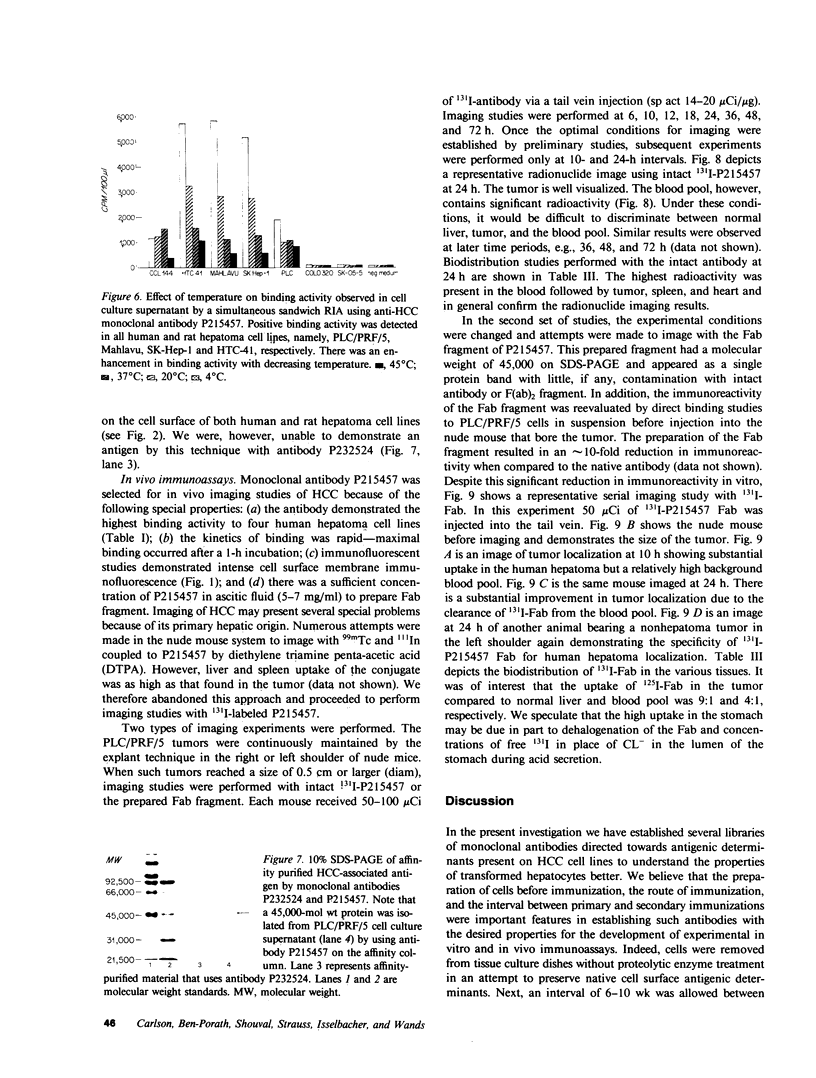

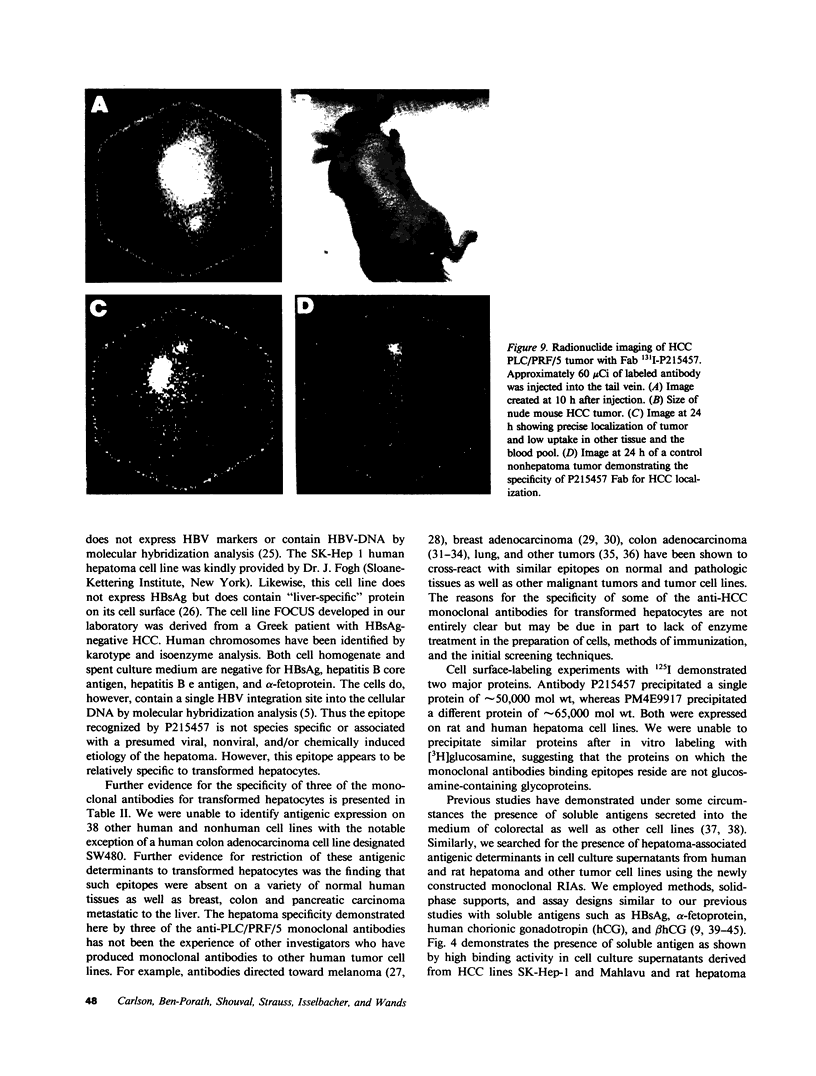
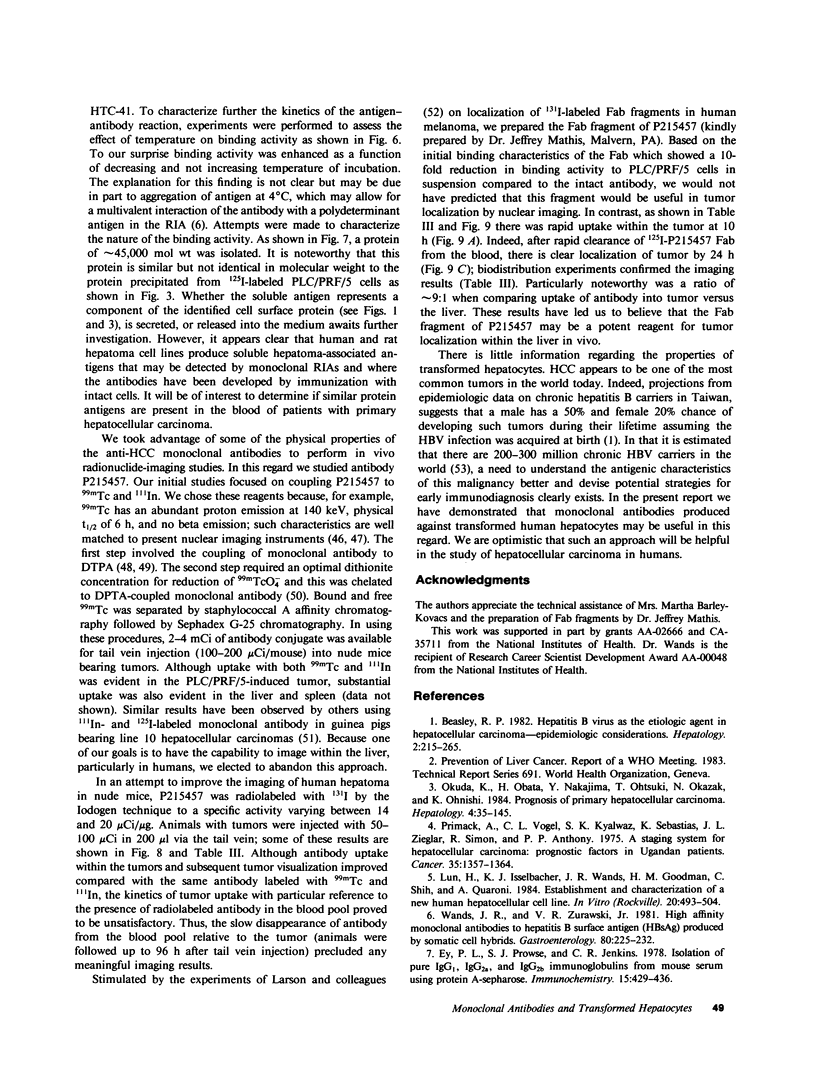
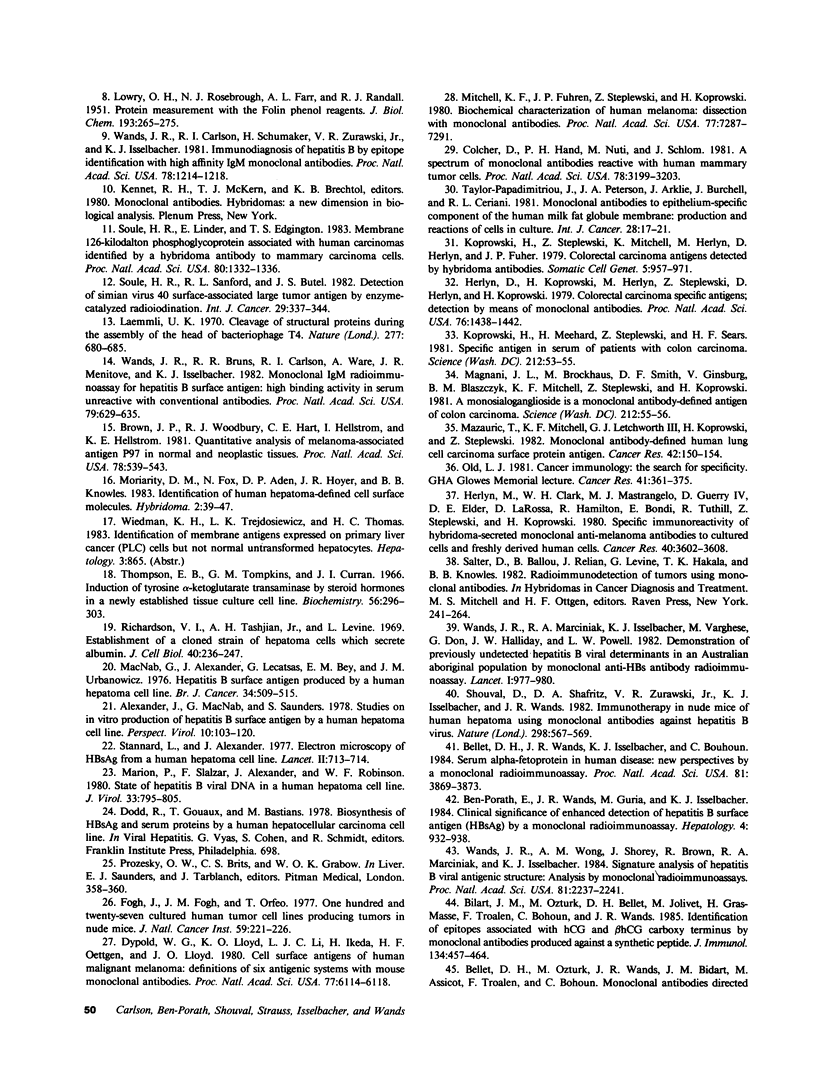
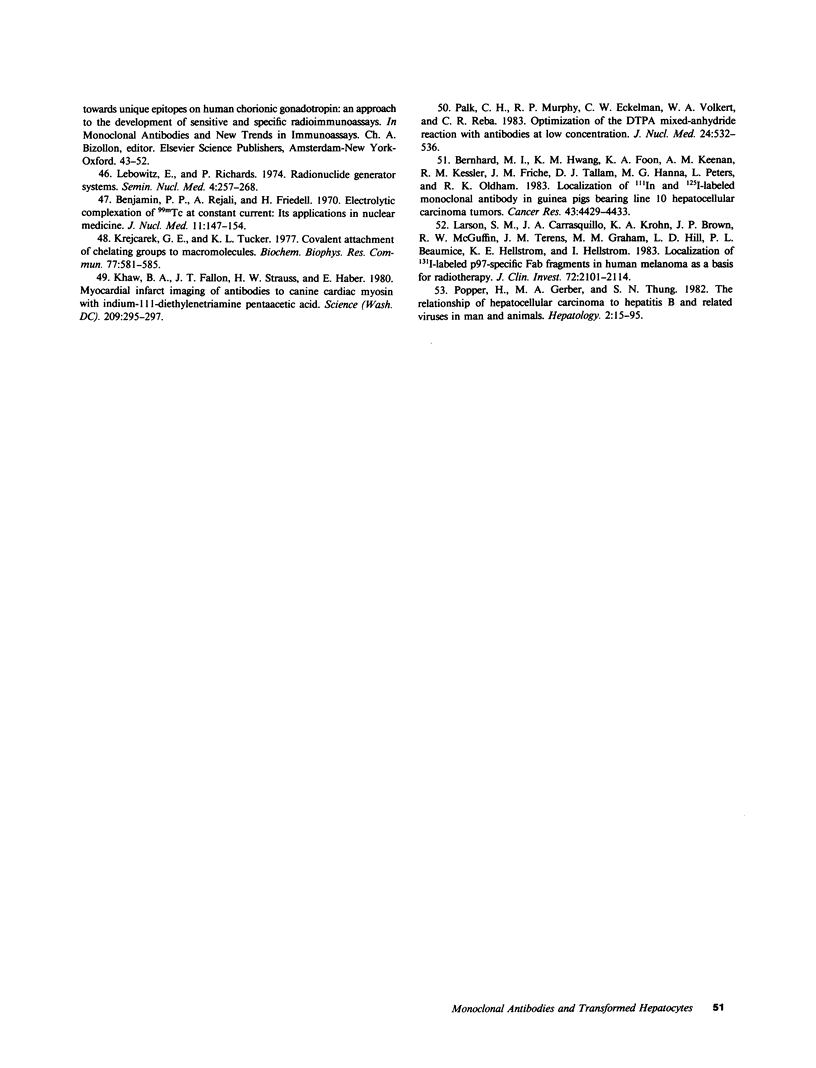
Images in this article
Selected References
These references are in PubMed. This may not be the complete list of references from this article.
- Bellet D. H., Wands J. R., Isselbacher K. J., Bohuon C. Serum alpha-fetoprotein levels in human disease: perspective from a highly specific monoclonal radioimmunoassay. Proc Natl Acad Sci U S A. 1984 Jun;81(12):3869–3873. doi: 10.1073/pnas.81.12.3869. [DOI] [PMC free article] [PubMed] [Google Scholar]
- Benjamin P. P., Rejali A., Friedell H. Electrolytic complexation of 99mTc at constant current: its applications in nuclear medicine. J Nucl Med. 1970 Apr;11(4):147–154. [PubMed] [Google Scholar]
- Bernhard M. I., Hwang K. M., Foon K. A., Keenan A. M., Kessler R. M., Frincke J. M., Tallam D. J., Hanna M. G., Jr, Peters L., Oldham R. K. Localization of 111In- and 125I-labeled monoclonal antibody in guinea pigs bearing line 10 hepatocarcinoma tumors. Cancer Res. 1983 Sep;43(9):4429–4433. [PubMed] [Google Scholar]
- Brown J. P., Woodbury R. G., Hart C. E., Hellström I., Hellström K. E. Quantitative analysis of melanoma-associated antigen p97 in normal and neoplastic tissues. Proc Natl Acad Sci U S A. 1981 Jan;78(1):539–543. doi: 10.1073/pnas.78.1.539. [DOI] [PMC free article] [PubMed] [Google Scholar]
- Colcher D., Hand P. H., Nuti M., Schlom J. A spectrum of monoclonal antibodies reactive with human mammary tumor cells. Proc Natl Acad Sci U S A. 1981 May;78(5):3199–3203. doi: 10.1073/pnas.78.5.3199. [DOI] [PMC free article] [PubMed] [Google Scholar]
- Dippold W. G., Lloyd K. O., Li L. T., Ikeda H., Oettgen H. F., Old L. J. Cell surface antigens of human malignant melanoma: definition of six antigenic systems with mouse monoclonal antibodies. Proc Natl Acad Sci U S A. 1980 Oct;77(10):6114–6118. doi: 10.1073/pnas.77.10.6114. [DOI] [PMC free article] [PubMed] [Google Scholar]
- Ey P. L., Prowse S. J., Jenkin C. R. Isolation of pure IgG1, IgG2a and IgG2b immunoglobulins from mouse serum using protein A-sepharose. Immunochemistry. 1978 Jul;15(7):429–436. doi: 10.1016/0161-5890(78)90070-6. [DOI] [PubMed] [Google Scholar]
- Fogh J., Fogh J. M., Orfeo T. One hundred and twenty-seven cultured human tumor cell lines producing tumors in nude mice. J Natl Cancer Inst. 1977 Jul;59(1):221–226. doi: 10.1093/jnci/59.1.221. [DOI] [PubMed] [Google Scholar]
- He L., Isselbacher K. J., Wands J. R., Goodman H. M., Shih C., Quaroni A. Establishment and characterization of a new human hepatocellular carcinoma cell line. In Vitro. 1984 Jun;20(6):493–504. doi: 10.1007/BF02619623. [DOI] [PubMed] [Google Scholar]
- Herlyn M., Clark W. H., Jr, Mastrangelo M. J., Guerry D. P., 4th, Elder D. E., LaRossa D., Hamilton R., Bondi E., Tuthill R., Steplewski Z. Specific immunoreactivity of hybridoma-secreted monoclonal anti-melanoma antibodies to cultured cells and freshly derived human cells. Cancer Res. 1980 Oct;40(10):3602–3609. [PubMed] [Google Scholar]
- Herlyn M., Steplewski Z., Herlyn D., Koprowski H. Colorectal carcinoma-specific antigen: detection by means of monoclonal antibodies. Proc Natl Acad Sci U S A. 1979 Mar;76(3):1438–1442. doi: 10.1073/pnas.76.3.1438. [DOI] [PMC free article] [PubMed] [Google Scholar]
- Khaw B. A., Fallon F. T., Strauss H. W., Haber E. Myocardial infarct imaging of antibodies to canine cardiac myosin with indium-111-diethylenetriamine pentaacetic acid. Science. 1980 Jul 11;209(4453):295–297. doi: 10.1126/science.7384803. [DOI] [PubMed] [Google Scholar]
- Koprowski H., Herlyn M., Steplewski Z., Sears H. F. Specific antigen in serum of patients with colon carcinoma. Science. 1981 Apr 3;212(4490):53–55. doi: 10.1126/science.6163212. [DOI] [PubMed] [Google Scholar]
- Koprowski H., Steplewski Z., Mitchell K., Herlyn M., Herlyn D., Fuhrer P. Colorectal carcinoma antigens detected by hybridoma antibodies. Somatic Cell Genet. 1979 Nov;5(6):957–971. doi: 10.1007/BF01542654. [DOI] [PubMed] [Google Scholar]
- Krejcarek G. E., Tucker K. L. Covalent attachment of chelating groups to macromolecules. Biochem Biophys Res Commun. 1977 Jul 25;77(2):581–585. doi: 10.1016/s0006-291x(77)80018-1. [DOI] [PubMed] [Google Scholar]
- Kuni C. C., Hasegawa B. H., Hendee W. R. Noise reduction in nuclear medicine images. J Nucl Med. 1983 Jun;24(6):532–534. [PubMed] [Google Scholar]
- LOWRY O. H., ROSEBROUGH N. J., FARR A. L., RANDALL R. J. Protein measurement with the Folin phenol reagent. J Biol Chem. 1951 Nov;193(1):265–275. [PubMed] [Google Scholar]
- Laemmli U. K. Cleavage of structural proteins during the assembly of the head of bacteriophage T4. Nature. 1970 Aug 15;227(5259):680–685. doi: 10.1038/227680a0. [DOI] [PubMed] [Google Scholar]
- Larson S. M., Carrasquillo J. A., Krohn K. A., Brown J. P., McGuffin R. W., Ferens J. M., Graham M. M., Hill L. D., Beaumier P. L., Hellström K. E. Localization of 131I-labeled p97-specific Fab fragments in human melanoma as a basis for radiotherapy. J Clin Invest. 1983 Dec;72(6):2101–2114. doi: 10.1172/JCI111175. [DOI] [PMC free article] [PubMed] [Google Scholar]
- Lebowitz E., Richards P. Radionuclide generator systems. Semin Nucl Med. 1974 Jul;4(3):257–268. doi: 10.1016/s0001-2998(74)80013-9. [DOI] [PubMed] [Google Scholar]
- MacNab G. M., Alexander J. J., Lecatsas G., Bey E. M., Urbanowicz J. M. Hepatitis B surface antigen produced by a human hepatoma cell line. Br J Cancer. 1976 Nov;34(5):509–515. doi: 10.1038/bjc.1976.205. [DOI] [PMC free article] [PubMed] [Google Scholar]
- Magnani J. L., Brockhaus M., Smith D. F., Ginsburg V., Blaszczyk M., Mitchell K. F., Steplewski Z., Koprowski H. A monosialoganglioside is a monoclonal antibody-defined antigen of colon carcinoma. Science. 1981 Apr 3;212(4490):55–56. doi: 10.1126/science.7209516. [DOI] [PubMed] [Google Scholar]
- Marion P. L., Salazar F. H., Alexander J. J., Robinson W. S. State of hepatitis B viral DNA in a human hepatoma cell line. J Virol. 1980 Feb;33(2):795–806. doi: 10.1128/jvi.33.2.795-806.1980. [DOI] [PMC free article] [PubMed] [Google Scholar]
- Mazauric T., Mitchell K. F., Letchworth G. J., 3rd, Koprowski H., Steplewski Z. Monoclonal antibody-defined human lung cell surface protein antigens. Cancer Res. 1982 Jan;42(1):150–154. [PubMed] [Google Scholar]
- Mitchell K. F., Fuhrer J. P., Steplewski Z., Koprowski H. Biochemical characterization of human melanoma cell surfaces: dissection with monoclonal antibodies. Proc Natl Acad Sci U S A. 1980 Dec;77(12):7287–7291. doi: 10.1073/pnas.77.12.7287. [DOI] [PMC free article] [PubMed] [Google Scholar]
- Moriarity D. M., Fox N., Aden D. P., Hoyer J. R., Knowles B. B. Identification of human hepatoma-defined cell surface molecules. Hybridoma. 1983;2(1):39–47. doi: 10.1089/hyb.1983.2.39. [DOI] [PubMed] [Google Scholar]
- Old L. J. Cancer immunology: the search for specificity--G. H. A. Clowes Memorial lecture. Cancer Res. 1981 Feb;41(2):361–375. [PubMed] [Google Scholar]
- Primack A., Vogel C. L., Kyalwazi S. K., Ziegler J. L., Simon R., Anthony P. P. A staging system for hepatocellular carcinoma: prognostic factors in Ugandan patients. Cancer. 1975 May;35(5):1357–1364. doi: 10.1002/1097-0142(197505)35:5<1357::aid-cncr2820350518>3.0.co;2-8. [DOI] [PubMed] [Google Scholar]
- Richardson U. I., Tashjian A. H., Jr, Levine L. Establishment of a clonal strain of hepatoma cells which secrete albumin. J Cell Biol. 1969 Jan;40(1):236–247. doi: 10.1083/jcb.40.1.236. [DOI] [PMC free article] [PubMed] [Google Scholar]
- Shouval D., Shafritz D. A., Zurawski V. R., Jr, Isselbacher K. J., Wands J. R. Immunotherapy in nude mice of human hepatoma using monoclonal antibodies against hepatitis B virus. Nature. 1982 Aug 5;298(5874):567–569. doi: 10.1038/298567a0. [DOI] [PubMed] [Google Scholar]
- Soule H. R., Lanford R. E., Butel J. S. Detection of simian virus 40 surface-associated large tumor antigen by enzyme-catalyzed radioiodination. Int J Cancer. 1982 Mar 15;29(3):337–344. doi: 10.1002/ijc.2910290318. [DOI] [PubMed] [Google Scholar]
- Soule H. R., Linder E., Edgington T. S. Membrane 126-kilodalton phosphoglycoprotein associated with human carcinomas identified by a hybridoma antibody to mammary carcinoma cells. Proc Natl Acad Sci U S A. 1983 Mar;80(5):1332–1336. doi: 10.1073/pnas.80.5.1332. [DOI] [PMC free article] [PubMed] [Google Scholar]
- Taylor-Papadimitriou J., Peterson J. A., Arklie J., Burchell J., Ceriani R. L., Bodmer W. F. Monoclonal antibodies to epithelium-specific components of the human milk fat globule membrane: production and reaction with cells in culture. Int J Cancer. 1981 Jul 15;28(1):17–21. doi: 10.1002/ijc.2910280104. [DOI] [PubMed] [Google Scholar]
- Thompson E. B., Tomkins G. M., Curran J. F. Induction of tyrosine alpha-ketoglutarate transaminase by steroid hormones in a newly established tissue culture cell line. Proc Natl Acad Sci U S A. 1966 Jul;56(1):296–303. doi: 10.1073/pnas.56.1.296. [DOI] [PMC free article] [PubMed] [Google Scholar]
- Wands J. R., Carlson R. I., Schoemaker H., Isselbacher K. J., Zurawski V. R., Jr Immunodiagnosis of hepatitis B with high-affinity IgM monoclonal antibodies. Proc Natl Acad Sci U S A. 1981 Feb;78(2):1214–1218. doi: 10.1073/pnas.78.2.1214. [DOI] [PMC free article] [PubMed] [Google Scholar]
- Wands J. R., Marciniak R. A., Isselbacher K. J., Varghese M., Don G., Halliday J. W., Powell L. W. Demonstration of previously undetected hepatitis B viral determinants in an Australian Aboriginal population by monoclonal anti-hbs antibody radioimmunoassays. Lancet. 1982 May 1;1(8279):977–980. doi: 10.1016/s0140-6736(82)91988-2. [DOI] [PubMed] [Google Scholar]
- Wands J. R., Wong M. A., Shorey J., Brown R. D., Marciniak R. A., Isselbacher K. J. Hepatitis B viral antigenic structure: signature analysis by monoclonal radioimmunoassays. Proc Natl Acad Sci U S A. 1984 Apr;81(7):2237–2241. doi: 10.1073/pnas.81.7.2237. [DOI] [PMC free article] [PubMed] [Google Scholar]
- Wands J. R., Zurawski V. R., Jr High affinity monoclonal antibodies to hepatitis B surface antigen (HBsAg) produced by somatic cell hybrids. Gastroenterology. 1981 Feb;80(2):225–232. [PubMed] [Google Scholar]



